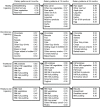Do dietary trajectories between infancy and toddlerhood influence IQ in childhood and adolescence? Results from a prospective birth cohort study
- PMID: 23516574
- PMCID: PMC3596350
- DOI: 10.1371/journal.pone.0058904
Do dietary trajectories between infancy and toddlerhood influence IQ in childhood and adolescence? Results from a prospective birth cohort study
Abstract
Objective: We examined whether trajectories of dietary patterns from 6 to 24 months of age are associated with intelligence quotient (IQ) in childhood and adolescence.
Methods: Participants were children enrolled in a prospective UK birth cohort (n = 7,652) who had IQ measured at age 8 and/or 15 years. Dietary patterns were previously extracted from questionnaires when children were aged 6, 15 and 24 months using principal component analysis. Dietary trajectories were generated by combining scores on similar dietary patterns across each age, using multilevel mixed models. Associations between dietary trajectories and IQ were examined in generalized linear models with adjustment for potential confounders.
Results: Four dietary pattern trajectories were constructed from 6 to 24 months of age and were named according to foods that made the strongest contribution to trajectory scores; Healthy (characterised by breastfeeding at 6 months, raw fruit and vegetables, cheese and herbs at 15 and 24 months); Discretionary (biscuits, chocolate, crisps at all ages), Traditional (meat, cooked vegetables and puddings at all ages) and, Ready-to-eat (use of ready-prepared baby foods at 6 and 15 months, biscuits, bread and breakfast cereals at 24 months). In fully-adjusted models, a 1 SD change in the Healthy trajectory was weakly associated with higher IQ at age 8 (1.07 (95%CI 0.17, 1.97)) but not 15 years (0.49 (-0.28, 1.26)). Associations between the Discretionary and Traditional trajectories with IQ at 8 and 15 years were as follows; Discretionary; 8 years -0.35(-1.03, 0.33), 15 years -0.73(-1.33, -0.14) Traditional; 8 years -0.19(-0.71, 0.33)15 years -0.41(-0.77, -0.04)). The Ready-to-eat trajectory had no association with IQ at either age (8 years 0.32(-4.31, 4.95), 15 years 1.11(-3.10, 5.33).
Conclusions: The Discretionary and Traditional dietary pattern trajectories from 6 to 24 months of age, over the period when food patterns begin to emerge, are weakly associated with IQ in adolescence.
Conflict of interest statement
Figures


References
-
- Hoefer C, Hardy MC (1929) Later development of breastfed and artificially fed infants: comparison of physical and mental growth. JAMA 92: 615–619.
-
- Kramer MS, Aboud F, Mironova E, Vanilovich I, Platt RW, et al. (2008) Breastfeeding and child cognitive development. Arch Gen Psychiatry 65: 578–584. - PubMed
-
- Kussmann M, Krause L, Siffert W (2010) Nutrigenomics: where are we with genetic and epigenetic markers for disposition and susceptibility? Nutr Rev 68: S38–S47. - PubMed
-
- Makrides M, Neumann MA, Byard RW, Simmer K, Gibson RA (1994) Fatty acid composition of brain, retina, and erythrocytes in breast- and formula-fed infants. Am J Clin Nutr 60: 189–194. - PubMed
Publication types
MeSH terms
Grants and funding
LinkOut - more resources
Full Text Sources
Other Literature Sources

